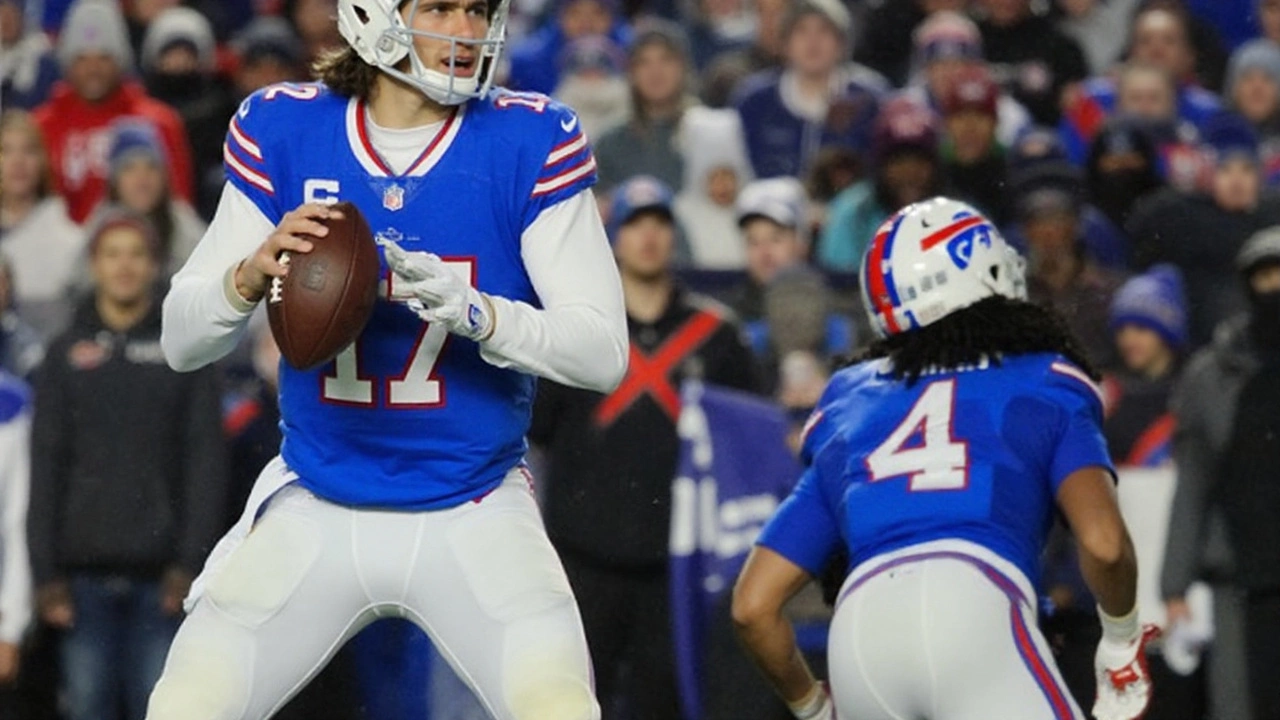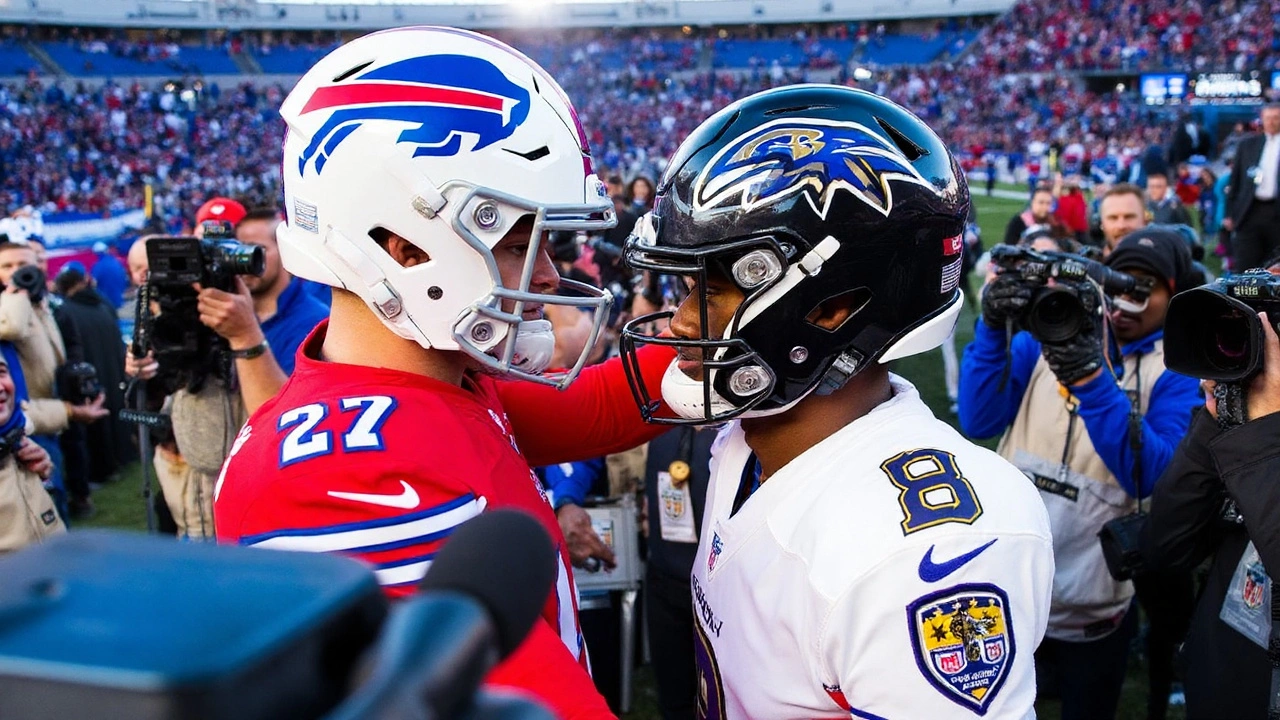Teams that score 40 or more and rumble for 235 on the ground do not lose. They were 277-0 across the NFL, playoffs included. That streak died in Orchard Park on opening night, where Buffalo turned a 40-25 hole into a 41-40 win with a surge that felt more like a plot twist than a football game.
On a clear September night in what’s set to be the Bills’ final season at Highmark Stadium, two MVP heavyweights put on a show worthy of primetime. Last year’s winner, Josh Allen, and runner-up, Lamar Jackson, met in the first season opener featuring the previous year’s top two MVP vote-getters since at least 1970, per the Elias Sports Bureau. Jackson was electric, moving the pocket, hitting windows, and grinding out yards on the ground. Allen stayed calm, played fast, and owned the last five minutes.
Baltimore did everything that usually ends games early: heavy personnel, downhill runs, time of possession, no interceptions, and star power. Derrick Henry bullied his way to 169 rushing yards and two scores, plus 13 receiving yards. It was the 13th game of his career with at least 150 rushing yards and two touchdowns, tying Jim Brown for the most in NFL history. Jackson added 70 rushing yards and a touchdown while posting a near-perfect passer rating. If you’re drawing up a winning script, that’s about as clean as it gets.
But games can flip on scattered moments. This one did. Both teams put the ball on the turf, and those fumbles mattered. Baltimore’s defense, so good through three and a half quarters, couldn’t finish drives with stops. Buffalo shifted into tempo, spread the field, and set edges better on defense. The Bills didn’t need miracles—just repeated execution with the clock bleeding away.
Trailing by 15 with five minutes left, the assignment for Allen was simple and brutal: score fast, burn as little clock as possible, force a quick stop, and do it again. Buffalo stacked late scoring possessions and saved the last snap for Matt Prater, who curled the walk-off field goal through as the stadium rocked under the lights. No interceptions from either side. No panic throws. Just relentless rhythm from an offense that suddenly looked inevitable.
How Buffalo cracked Baltimore’s grip
What changed? Plenty, and all of it showed up in the margins. Buffalo found success with quick outs and intermediate crossers that kept the chains moving without inviting sacks. The Bills stressed Baltimore horizontally, then used that space to take chunk gains down the seams. On the other side, the Ravens got a little conservative, settling for clock and field position over their earlier aggression.
- Tempo and spacing: Buffalo’s hurry-up limited Baltimore’s substitutions and softened zones. When the Bills kept the ball moving, the Ravens’ pass rush couldn’t tee off.
- Sideline management: Buffalo worked the boundary with precision, gaining first downs and stopping the clock. That kept the full playbook open while protecting timeouts.
- Ball security pressure: While there were no interceptions, traffic tackles and strips shaped the fourth quarter. Even when fumbles didn’t flip possessions, they rattled rhythm.
- Special teams edge: The final kick matters most, but Buffalo’s operation—snap, hold, protection—was smooth when nerves usually fray.
The Ravens’ plan had been nearly flawless. They won the line of scrimmage for most of the night. Henry’s cutbacks punished over pursuit. Jackson manipulated linebackers with option looks and RPO action. When Baltimore led 40-25, it matched the way they wanted the game to look—clock, body shots, and a defense ready to close.
Buffalo’s defense found late answers on its edges, closing inside-out lanes that were open earlier. That forced Henry to work laterally more often, and it nudged Baltimore toward throws into tighter windows. Jackson still made plays—he usually does—but the surgically clean drives weren’t as easy to find down the stretch. One stalled possession is all you need when the other sideline is sprinting.
It’s rare to see a game flip without a tipped-ball interception or an explosive special-teams return. That’s what makes this one stand out. Buffalo just won the small battles on repeat. Third downs shortened. Out-of-bounds stops stacked. The pocket seconds added up. And then Prater finished the work with the kind of poise teams crave in Week 1.

What it means for both teams
For the Bills, this is more than a 1-0 start. It’s validation that their MVP quarterback can recalibrate a game even when an elite run attack is chewing clock. It’s a statement in a loaded AFC, where Buffalo and Baltimore opened tied for the shortest conference odds at +325. Resume wins matter, and this one might echo for months when seeding talk heats up.
It’s also a boost for a fan base savoring one last season in this building. The environment was loud all night, and in the final minutes it was deafening. Home-field isn’t a number on a spreadsheet. You felt it as the Ravens tried to change plays at the line and missed half steps in coverage.
For Baltimore, the loss stings on several levels. It’s now the eighth time under John Harbaugh that the Ravens have lost a game after leading by at least eight in the fourth quarter—the most for any coach since 2000. Coaches hate patterns like that because they invite questions about late-game choices: play-calling pace, fourth-down thresholds, coverage shells, and how much to trust the ground game when everyone knows it’s coming.
That said, this wasn’t some crumbling foundation. The Ravens just ran for 235, got a star-level night from their quarterback, and watched an all-time closer in Henry tie a Jim Brown mark. The defense created real problems for three quarters. A couple of first downs late, or one contested catch going their way, and the narrative flips. Week 1 can be the overreaction factory. The tape will show enough positives to carry into September.
There’s also context that matters. This was a heavyweight fight. Last January, the Bills edged Baltimore 27-25 in the divisional round. The rematch arrived with even more juice—a primetime stage and MVP billing—and it delivered. That these teams produced another one-score thriller isn’t a coincidence. The margins between them are razor-thin.
The stat line underscores how almost-impossible the result was. Teams were 277-0 when scoring at least 40 and rushing for 235 or more. Baltimore did both and still lost. That doesn’t happen without a cascade of small moments: a missed tackle that nudges a first down, a ball poked loose in a crowd, a sideline route that stops the clock by an inch. Stack enough of those, and even history can’t hold.
Allen’s late-game calm will draw obvious praise, and it should. So will Prater’s steadiness after a long night where every kick felt heavy. On the other sideline, Jackson and Henry were every bit as advertised. If this is the baseline for both offenses, future defenses will need fresh answers. Tackling angles. Fit discipline. Red-zone disguise. There’s a winter’s worth of problems on that film.
For fans, this was instant canon. For both locker rooms, the lesson is more practical. Baltimore has to close drives and resist drifting into bend-but-break in the fourth. Buffalo can’t spot that many rushing yards and expect late magic every Sunday. But you can see why both were the AFC favorites. When they’re on the same field, the sport feels a little bigger.
Bookmark this one as a reference point. If you’re tracking the AFC race, tiebreakers, and home-field paths in January, the first clue may have arrived in Week 1. And yes, it came courtesy of a walk-off under the lights in a game that turned the record book upside down. If you were searching for the best way to describe it in three words: Bills vs Ravens.



